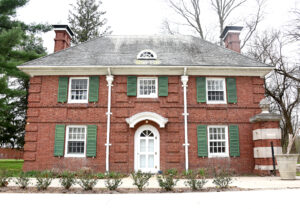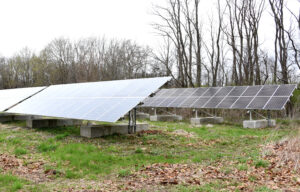MONTICELLO — Starting with the installation of wood-burning boilers in 2009 and 2010, Allerton Park and Retreat Center has made a commitment to renewable energy as it makes progress toward a goal of being carbon neutral by 2035.
Since that first boiler was installed 13 years ago, the park has also put in three solar arrays, which provide most of the power to five buildings in the Visitor Center Com plex.
plex.
The power of the sun also provides energy to utility boxes in the Meadow, meaning that concerts held there in recent years were actually solar powered.
“That’s one thing people don’t know when they attended those concerts,” said Allerton Director Derek Peterson.
Deep geothermal systems have also reduced electricity and gas usage, providing renewable energy at the Gatehouse and Evergreen Lodge.
Eventually, a larger energy project will get the park to carbon neutral. In the meantime, Peterson said more small-scale efforts will continue.
“We will go back to the drawing board a little bit and look for smaller projects that have smaller impacts, but we do a lot of them. So that equates to a big impact,” he said.
Those include envelope-sealing efforts such as adding insulation to buildings.
Here are some of the projects Allerton has undertaken over the last decade-plus to reduce its carbon footprint.
—SOLAR POWERED MUSIC? Did you know that the Sam Bush and Jerry Douglas concert in the Allerton meadow five years ago was partially solar powered? Solar arrays at Allerton power buildings, charge golf carts and hand-held power tools, and feed the outdoor power boxes on the meadow.

—GEOTHERMAL ENERGY IN USE: Another effort is an underground geothermal field which provides power for the Gatehouse. Geothermal methods are considered renewable because they use deep wells to provide heat produced continuously inside the earth. Geothermal also helps power the Evergreen Lodge.
—WOOD POWER: Two wood-burning boilers located near the Allerton Visitor Center complex, installed in 2009-2010, were one of the first major modern-day efforts to use renewable energy at the park. They help provide heat to the Greenhouse Café, the Regency (future McCraw Family Visitor Center), car shop, paint shop and maintenance shed.
Allerton Associate Director of Operations Richard Burton compiled this list of green projects undertaken at Allerton since 2008.
- Retreat Center boiler replacement — In the spring summer of 2008 the old inefficient steam boilers were replaced and converted to a hot water system with two high-efficient modulating boilers. With their operation we have reduced our gas usage in the Retreat Center by about 45% annually.
Visitor Center complex woodburning boilers — The first boiler was installed in 2009 and the second one was added in 2010. With their operation we have reduced our natural gas consumption by around 60% annually. Buildings include the Greenhouse Café, Regency/Visitors Center, car shop, paint shop, and maintenance shed.
Evergreen Lodge geothermal system — This system was installed in November of 2011. It replaced a very old and inefficient system with electric baseboards heaters for heating. With its operation we have reduced our electrical use for that building an average of around 30% annually.
- Gatehouse geothermal system —This system was installed in June of 2014. It replaced an 80% natural gas fired boiler and old inefficient AC system. With is operation we reduced our natural gas usage to this building by 92% annually. It has increased the electrical demand by around 20% annually. The total utility savings would be somewhere around 30% annually.
- Maintenance Shed solar array — This system was installed in January of 2014. Its lifetime production to date is 106 MWH. This is equivalent to a carbon offset of 73 tons.
- Visitors Center solar array 1 — This system was installed in May of 2014. Its lifetime production to date is 138 MWH. This is equivalent to a carbon offset of 95.4 tons.
- Visitors Center solar array 2 —This system was installed in January of 2021. Its lifetime production to date is 23.4 MWH, this equivalent to a carbon offset of 16.2 tons.

